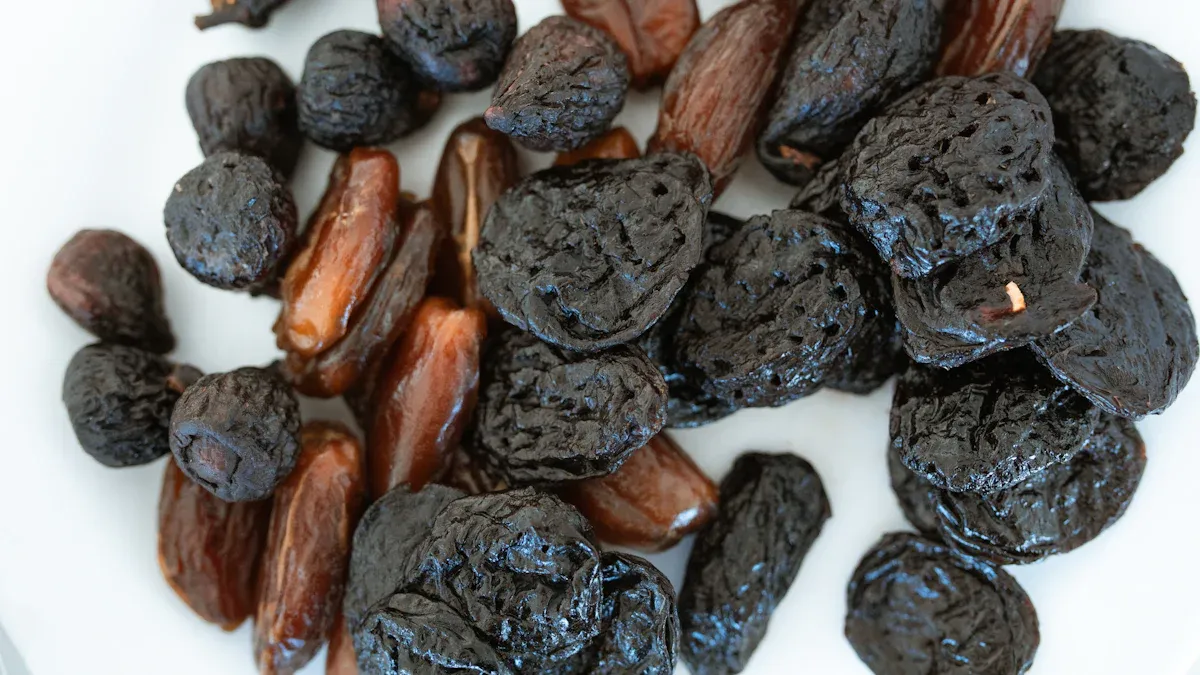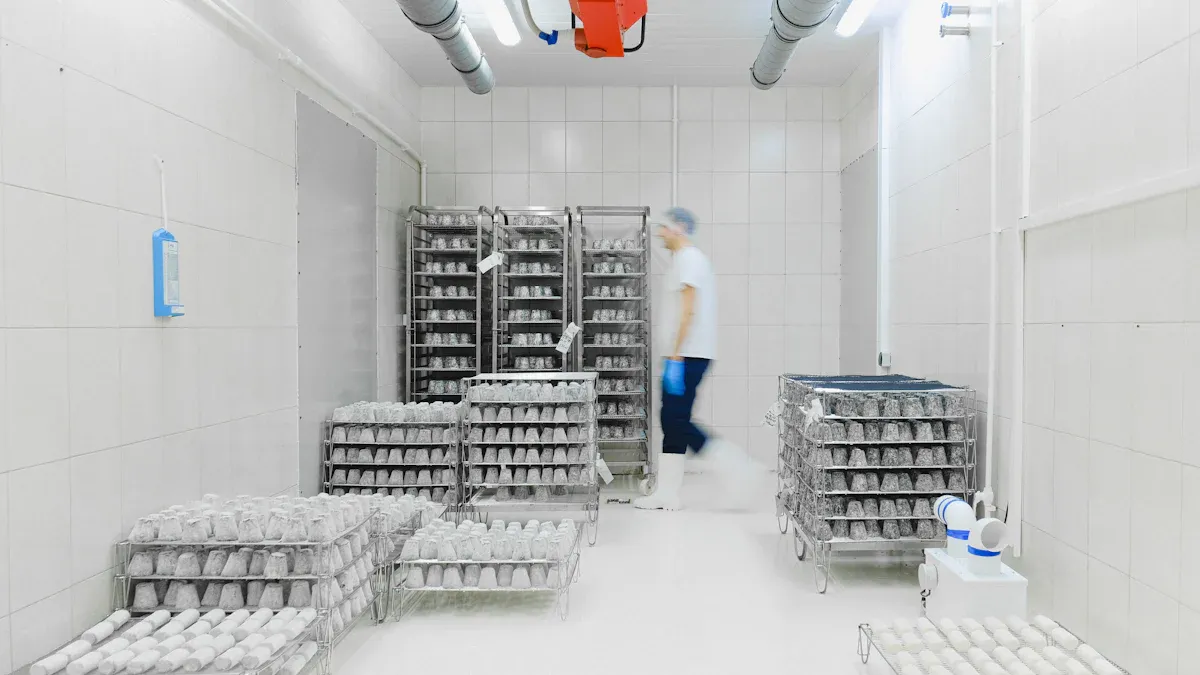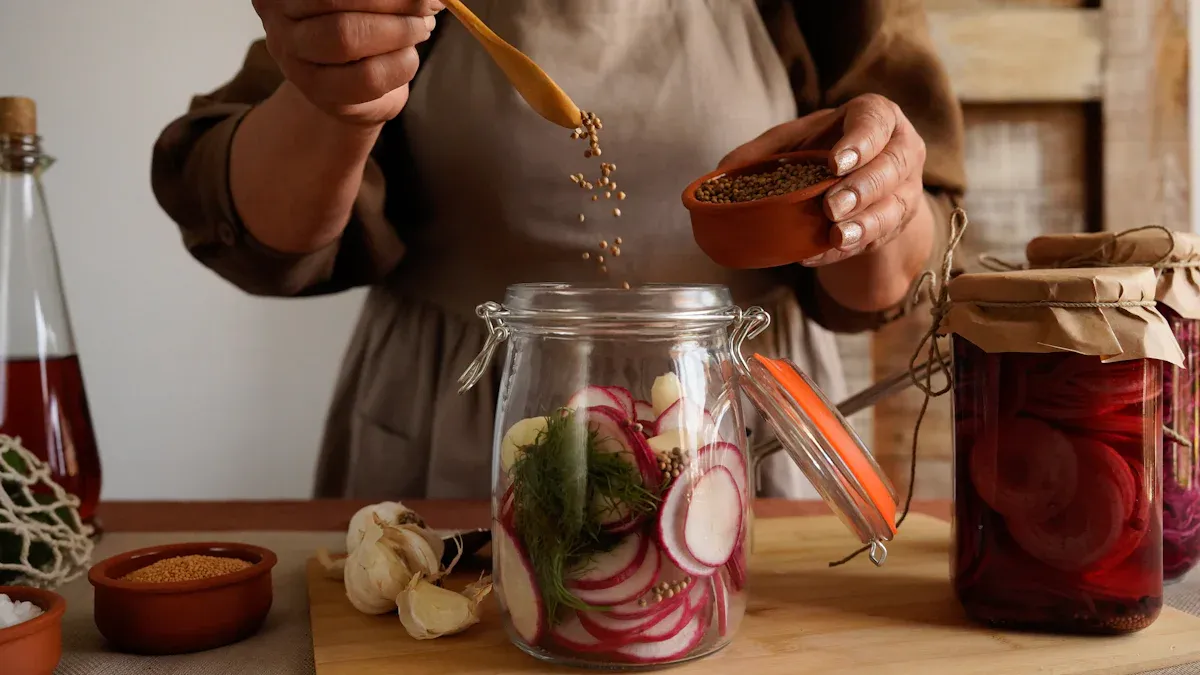What You Need to Know About Dates Cold Room Storage

To keep your dates at peak freshness, store them in a dates cold room set between 32°F and 41°F (0°C to 5°C). Choose airtight containers to protect against moisture loss and oxidation. High humidity, around 65–75 percent, helps stop the dates from drying out. You can use a dates cold room at home or in a small business. By controlling temperature and sealing your dates well, you prevent spoilage and extend their shelf life.
Key Takeaways
Keep dates in a cold room at 32°F to 41°F. This helps slow down spoilage. It also keeps dates fresh for more days.
Keep humidity between 65% and 75%. This stops dates from drying out. It also helps stop mold from growing.
Use airtight or vented containers for storing dates. These keep out air and moisture. They also stop water from getting trapped inside.
Give dates space so air can move around them. Label each container to know how fresh the dates are. This helps you not waste any dates.
Check the temperature and humidity often. Also, check the dates to see if they are still good. This helps you find problems early and enjoy tasty dates longer.
Why Use Dates Cold Room
Slowing Spoilage
You want your dates to last as long as possible. A dates cold room helps you slow down spoilage by keeping the temperature low. Bacteria and mold grow much slower in cold conditions. When you store dates at 32°F to 41°F (0°C to 5°C), you create an environment where harmful microbes cannot multiply quickly. This means your dates stay safe to eat for a longer time.
Tip: Always check that your cold room stays within the recommended temperature range. Even small changes can let bacteria grow faster.
Cold storage works for dates just like it does for other fruits. Many people use cold rooms for apples, berries, and grapes. You use the same science for dates. By lowering the temperature, you slow down the natural processes that cause food to go bad.
Preserving Flavor
You want your dates to taste sweet and fresh every time you eat them. Cold room storage helps you keep the natural flavor and texture of dates. High temperatures can break down sugars and antioxidants in dates. When you use a cold room, you protect these important compounds.
A cold room also keeps the moisture inside the dates. Dry air can make dates hard and less tasty. By using the right humidity, you keep dates soft and chewy. This method of food preservation helps you enjoy the best quality dates for months.
Note: Cold storage is a proven way to keep fruits fresh. You can trust this method for your dates and other produce.
Cold Room Conditions

Temperature Range
You need to keep the right temperature in your dates cold room. The best range for storing dates is 32°F to 41°F (0°C to 5°C). This range slows down the growth of bacteria and mold. When you set the temperature too high, dates can spoil quickly. If you set it too low, you risk freezing the dates, which can change their texture and taste.
A stable temperature helps you keep dates fresh for a long time. Fluctuations in temperature can cause condensation inside containers. This moisture can lead to mold and spoilage. You should check the temperature daily with a reliable thermometer. Many cold rooms have digital displays that make this easy.
Tip: Place a thermometer in different spots in your dates cold room. This helps you find any warm or cold areas that could affect your dates.
Humidity Control
Humidity plays a big role in keeping dates soft and tasty. The ideal humidity level for a dates cold room is between 65% and 75%. If the air is too dry, dates lose moisture and become hard. If the air is too wet, mold can grow on the surface of the dates.
You can use a hygrometer to measure humidity. Some cold rooms have built-in humidity controls. If yours does not, you can add trays of water to raise humidity or use a dehumidifier to lower it. Always keep the humidity steady. Sudden changes can damage the quality of your dates.
Here is a simple table to help you remember the best conditions:
Condition | Ideal Range |
|---|---|
Temperature | 32°F to 41°F (0°C to 5°C) |
Humidity | 65% to 75% |
Ventilation
Proper ventilation is key to a healthy dates cold room. Good airflow keeps the environment stable and prevents moisture from building up. When air moves through the room, it carries away excess heat and moisture. This helps you avoid mold and spoilage.
In many cold rooms, vents at the top and bottom allow air to circulate. Warm air rises and leaves through the top vent. Cool air enters through the bottom. This passive airflow creates a dry and slightly cool space. You want to keep this airflow steady. Blocked vents or poor circulation can trap moisture and raise the risk of spoilage.
Note: Always check that nothing blocks the vents in your dates cold room. Good ventilation works with the right temperature and humidity to keep your dates fresh and safe.
Preparation and Packaging

Cleaning Dates
You want your dates to be fresh and safe. Start by cleaning them before putting them in the cold room. First, look at all the dates and take out any that are damaged or have mold. Use clean hands or gloves when you touch the fruit. If you see dirt or dust, wipe the dates with a dry cloth. For sticky spots, use a damp cloth, but make sure the dates are dry before storing. Wet dates can spoil faster in storage. Let the dates dry on a clean towel. This helps stop mold and keeps your storage area clean.
Tip: Always look for bugs or small pieces of dirt before packing your dates. Clean dates last longer and taste better.
Airtight Containers
Picking the right container helps your dates stay fresh longer. Many people use airtight containers like Mason jars or plastic freezer bags. These keep out air and water, which stops the dates from drying out. But airtight containers can also trap water and gases inside. This can make dates spoil or ripen too fast, especially if they are not dry.
Some containers, called produce keepers, have vents you can open or close. These let you control how much air and water get in. Produce keepers often work better than airtight containers for dates. They help stop too much water from building up, which can cause mold. Glass and BPA-free plastic are good choices for storing dates. Pick a container that fits your needs and the size of your cold room.
Here is a simple table to compare packaging options:
Packaging Type | Pros | Cons |
|---|---|---|
Airtight Containers | Blocks air and water, easy to find | Can trap water, risk of spoilage |
Polyethylene Bags | Flexible, cheap, easy to seal | May not control water well |
Produce Keepers | Vents for air and water control | May cost more, need more space |
Note: For best results, use containers with vents you can adjust. These help you balance water and air, so your dates stay fresh longer in storage.
Modified Atmosphere Bags
Modified atmosphere bags are another way to store dates in a cold room. These bags change the air inside by lowering oxygen and raising carbon dioxide. This slows down ripening and helps stop spoilage. You often see these bags in stores, but you can use them at home too.
To use these bags, put clean, dry dates inside and seal the bag tight. The special bag lets some gases move in and out. This keeps the dates from losing water and stops mold from growing. Modified atmosphere bags work well for long-term storage, especially if you want to keep dates for months.
Tip: Always seal your bags or containers tight. Good sealing stops air and water loss, which are the main reasons dates spoil.
Storage Setup and Freezer Use
Arranging Dates
You want your dates to stay fresh and safe in storage. Arrange them in a way that lets cold air move around each container. Do not overcrowd your shelves. Leave gaps between each package so air can flow freely. Always keep vents clear, as blocked vents can cause uneven cooling and lead to frost buildup. Place dates with the earliest expiration dates in front. This helps you use older dates first and keeps your stock rotating. Clean your storage area often to prevent bacteria and frost from forming. If you share your cold room with other foods, keep dates on upper shelves and away from raw items. Use airtight containers and label everything with the date of storage. This helps you track freshness and avoid cross-contamination, which protects the quality of your dates.
Freezer Storage
Sometimes you need to store dates for a long time. The freezer is the best choice for this. Choose an upright freezer for easy access and better organization. The best upright freezer keeps a steady temperature and helps with frost prevention. When you use an upright freezer, pack dates in airtight containers or freezer bags. Remove as much air as possible to protect the quality and stop frost from forming. Arrange containers so air can move around them. Do not stack too many items together. The best upright freezer has shelves that let you separate batches and keep track of expiration dates. If you want to avoid frost, pick the best upright freezer with good insulation and a reliable door seal. Check your upright freezer often for signs of frost. If you see frost, clean it out to keep the freezer working well. The best upright freezer helps you keep dates at top quality for months.
Monitoring
You need to check your storage conditions often to keep dates at their best quality. Use a thermometer and hygrometer to watch temperature and humidity. Place sensors in different spots in your upright freezer and cold room. This helps you find any warm or cold areas. The best upright freezer uses cold-rated parts that work well even with frost. Some upright freezers have alarms that warn you if the temperature changes. Write down your temperature and humidity checks. Many people check every five minutes, but you can adjust this to fit your needs. Use a table like this to help you:
Parameter | Default Interval | Adjustable Range |
|---|---|---|
Temp Check Interval | Down to 30 seconds | |
Transmission Interval | 30 minutes | 1 minute up to 24 hours |
If you use a smart upright freezer, you can track everything with software. This helps you spot problems fast and keep your dates at the highest quality. Regular checks help you catch frost early and keep your upright freezer running smoothly.
Shelf Life and Spoilage
Expected Shelf Life
You can keep dates fresh for a long time if you use the right storage. In a cold room, dates often last up to 6 months. If you want to store them even longer, use a freezer. Dates in a freezer can stay good for up to a year. The upright freezer works well because it keeps a steady temperature. You protect the quality of your dates by using airtight containers and keeping the freezer at the right setting. Always label your containers with the date you stored them. This helps you track how long they have been in the freezer and keeps your quality high.
Storage Method | Expected Shelf Life |
|---|---|
Cold Room | Up to 6 months |
Freezer | Up to 12 months |
Tip: Use an upright freezer for easy access and better organization. This helps you check the quality of your dates quickly.
Signs of Spoilage
You need to check your dates often to make sure they are still safe to eat. Look for these signs:
Mold on the skin or inside the fruit
Bad or sour smell
Sticky or slimy texture
Unusual spots or colors
Condensation inside the container
If you see any of these signs, do not eat the dates. Remove spoiled dates right away to protect the quality of the rest. A good freezer slows down spoilage, but you still need to check your dates often.
Common Mistakes
Many people make mistakes that lower the quality of their dates. Here are some common ones:
Letting the temperature in the freezer change too much
Using containers that are not airtight
Overcrowding the upright freezer so air cannot move
Forgetting to check the quality of dates often
Not labeling containers with storage dates
You can avoid these mistakes by checking your freezer settings, using the right containers, and keeping your upright freezer organized. Always focus on keeping the quality high. Regular checks help you catch problems early and stop spoilage before it spreads.
To make sure your dates stay fresh, do these things:
Keep dates in a cold room or freezer with the right temperature and humidity.
Put dates in airtight containers to keep them good.
Look at your storage often to check the conditions.
Tip: Check your storage setup every few months. This helps you keep your dates fresh and stops them from going bad. If you follow these steps, you can enjoy tasty dates for a longer time.
FAQ
How do you know if dates are still good after cold storage?
Check for mold, bad smells, or sticky spots. Good dates look shiny and feel soft. If you see white spots or smell something sour, throw them away. Always check your dates before eating.
Can you freeze dates more than once?
You should not freeze dates more than once. Thawing and refreezing can change the texture and taste. For best results, freeze dates in small portions. Take out only what you need each time.
What is the best container for storing dates in a cold room?
Use airtight containers or produce keepers with vents. Glass jars and BPA-free plastic boxes work well. These containers keep air and moisture out. Always label your containers with the storage date.
Do dates need to be washed before storage?
You should clean dates before storage. Wipe off dirt with a dry or damp cloth. Let them dry completely before packing. Clean dates last longer and stay safe to eat.
Can you store different types of dates together?
You can store different types together if they are all clean and dry. Keep them in separate containers if you want to keep flavors and textures unique. This helps you enjoy each type at its best.
See Also
The Importance Of Cold Rooms For Product Freshness
Ways Cold Rooms Prevent Contamination In Food Storage
Comparing Container Cold Rooms And Conventional Storage Methods

